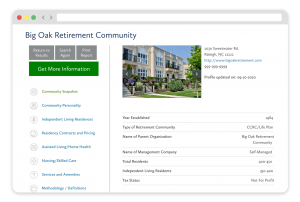Many new senior living residents use the equity from the sale of a home to cover most or all of their move to senior living. However, there are times when someone may not own a home, or had previously sold their home before downsizing to an apartment, for example, and now they are considering the best options for funding the move. This is a particularly important consideration for those who are moving to a continuing care retirement community (CCRC or “life plan community”) since many of them require a sizable entry fee in exchange for priority access to a continuum of care and other potential benefits.
One of the senior living funding options occasionally considered is a cash-value life insurance policy. Some older adults may have purchased policies years ago that have accumulated quite a bit of cash value over the years. If there is no longer a big need for life insurance coverage, then the question may be whether it is reasonable to use the policy’s accumulated cash to cover a senior living move.
The life insurance policy options
I want to emphasize that using cash value from a life insurance policy is something that you should discuss with a financial professional and a tax advisor before making any decisions. This post should not be considered personal financial advice.
Before we talk about withdrawing cash from a life insurance policy, it may first be helpful to have some context about why cash-value policies exist to begin with and what allows for such policies’ cash accumulation.
There are two primary types of life insurance coverage: term life insurance policies and permanent life insurance policies, sometimes called “cash-value” policies.
Term life insurance policies are generally the least expensive type of life insurance coverage. It only lasts for a set period of time, and there is no cash value accumulation. Examples are 10-year, 20-year, and even 30-year policies. As long as the premium is paid, coverage is provided, but once the term ends, the coverage ceases.
If coverage is still needed at the end of the term, the insured would need to buy a new policy. And since they would be older at that point, the premium for the new policy would be substantially higher, assuming they still qualify for coverage based on their health. Term insurance is typically best for a temporary need, even though the “term” may stretch as long as 30 years.
Permanent life insurance policies (aka cash-value policies), on the other hand, are designed to last for life, or as long as the insured wants to keep the policy. For those who want to ensure they maintain at least some coverage over their full lifetime without having to worry about drastically rising premiums later, permanent insurance is more appropriate.
If properly funded, the owner of a permanent policy should not have to pay higher premiums in the future, even though, compared to term insurance, they will pay a higher premium in the early years. Cash value accumulation is the reason this is possible.
>> Related: Can I Use My Long-Term Care Insurance in a CCRC?
A closer look at how permanent cash-value policies work
In simple terms, permanent life insurance works by having the policyholder pay more in premiums during the early years than the actual cost of providing insurance at that time. The excess is set aside in a cash-value account, which grows on a tax-advantaged basis.
As the insured gets older and the pure cost of insurance naturally rises, there is a cross-over point at which the internal cost of insurance is higher than the premium being paid. At this point, the policy begins drawing on this accumulated cash value to help cover the higher costs, allowing the policyholder’s required premium payments to remain level. Therefore, the policy relies increasingly on the built-up reserves to offset the gap between the fixed premium and the growing insurance charges.
If the policy’s cash value grows enough, aided by the effect of compounding interest over time, it can continue to increase even while some of it is being used to subsidize the rising cost of insurance.
Whether or not the policy works out as described depends largely on the type of policy and whether it is properly funded in the early years. Some policies allow flexible premiums, which means the premium amounts can be adjusted within a range. However, if the policy is not properly funded, then the cash value may never accumulate enough to offset the increasing cost of insurance later. As a result, the cash value would begin to deplete instead of grow. If the policy eventually runs out of cash, it will lapse and the coverage will cease to exist.
While a detailed explanation of each is beyond the scope of this blog post, there are many different types of permanent life insurance policies, including (but not limited to):
- Whole life
- Universal life (UL)
- Variable universal life (VUL)
- Equity-indexed universal life
- Hybrid policies that include a long-term care insurance (LTCi) component
With VUL’s, the cash reserves are actually invested into sub-accounts, which function similarly to mutual funds. In this case, just like any type of investment, the cash value can fluctuate depending on the performance of the sub-accounts.
>> Related: I’m Moving to a CCRC: Should I Keep my Long-Term Care Insurance?
What to know before using life insurance to pay for senior living
Okay, let’s get back to the question of using life insurance to pay for senior living. In this hypothetical scenario, let’s assume the policy has been properly funded and there is cash value available. This is what you should understand before tapping into a permanent life insurance policy’s cash value to pay for your senior living move:
Is there a surrender charge?
Most permanent life insurance policies have a surrender penalty that applies if the policy is cashed out in the early years. In some cases, the surrender period may last as long as 20 years or more. Before cashing out a policy, it’s important to be sure there is no applicable surrender penalty to do so.
Does the cash value exceed the amount of total premiums paid?
Hopefully, the answer is yes, but this does mean there can be tax implications of a withdrawal. One nice thing about withdrawals from life insurance cash values is that, under current tax code, it’s treated as first in, first out (FIFO). This means withdrawals are first considered a return of cost basis.
After the cost basis is fully withdrawn, all additional distributions will be taxed as ordinary income. The tax due on these withdrawals will depend on your tax bracket. Also, unlike most retirement accounts and annuities, life insurance withdrawals are not subject to age 59 ½ early withdrawal penalties. (See the next point for an exception to this.)
Is the policy a modified endowment policy (MEC)?
Life insurance policies have a limit on how much premium you can pay. If someone “overfunds” a policy, perhaps seeking to capitalize on the tax-advantaged growth, it can be classified as a modified endowment policy (MEC). In this case, withdrawals are taken under last in, first out (LIFO), and therefore gains are required to be taken first. Additionally, 59 ½ early withdrawal penalties may apply.
Is it a full or partial withdrawal?
A full withdrawal of the cash value will cause the policy to terminate, which may be okay if it’s determined the coverage isn’t needed any longer. A partial withdrawal, however, typically lowers the coverage amount on a dollar-for-dollar basis, although some policies will allow withdrawals up to a certain percentage before this happens.
An alternative to a cash withdrawal would be a loan against the policy. A loan technically does not lower the coverage amount because it can be paid back. However, if the insured should pass away with an outstanding loan, then the loan balance will be deducted from the coverage. Loans also are not taxable when withdrawn. However, if the loan balance accumulates and eventually causes the policy to lapse, it could trigger a taxable event at that time.
>> Related: Paying for Senior Living- Know Your Options
Make an educated decision on paying for senior living with life insurance
As you can see, there are options for extracting cash from a life insurance policy that is no longer needed, but understanding the potential tax implications is important. Also, if you plan to leave an inheritance to your children or grandchildren, keep in mind that life insurance is often one of the best ways to do so because:
- It avoids probate (assuming a beneficiary is named on the policy).
- It is paid out tax-free to the beneficiary.
- It is provided for pennies on the dollar. (For example, if a policy has a $500,000 death benefit and total premiums paid over the years are $75,000, that’s more than a 6x return on those dollars. Not too bad!)
One other point to note: There are companies called life settlement providers or life settlement brokers that will actually buy a life insurance policy. Typically, they pay the policyholder more than the cash value but less than the death benefit, and then the life settlement company is designated as the beneficiary of the policy. Essentially, these life settlement businesses operate by making money when the policyholder dies. Though it might sound a little unorthodox, there are legit companies that offer this service, but as with most things money-related, there are also scammers, so use caution.
So bottom line: Whether cashing out a life insurance policy to pay for your senior living, selling it, or saving it for your heirs, the key is to do your due diligence and understand the details of your policy so you can make an informed financial decision. Again, it is essential to talk with an experienced attorney and accountant to determine how various payment scenarios will impact your finances, your taxes, and your heirs.

FREE Detailed Profile Reports on CCRCs/Life Plan Communities
Search Communities






